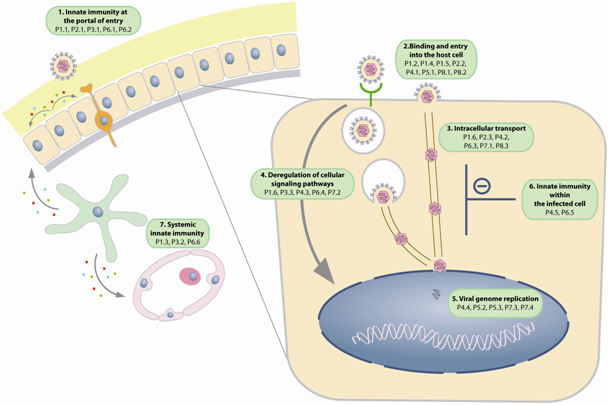Virus-host interplay at the early stages of infection
IAP 7/45
Summary of the project
 Figure 1: Model illustrating the different early events of viral infection that will be investigated by the BELVIR consortium. The numbers of the different work packages are provided for each host-virus interaction. The cycle of an herpesvirus is taken as an example.
Figure 1: Model illustrating the different early events of viral infection that will be investigated by the BELVIR consortium. The numbers of the different work packages are provided for each host-virus interaction. The cycle of an herpesvirus is taken as an example.
Viral infections have caused an enormous burden, both in human and veterinary medicine. Constant exposure to viral infections has driven host evolution and continues to provide some of the most pressing challenges in global health. The outcome of the infection of a naive host by a virus relies on key virus-host interactions that occur early after the first contact between virus and host. However, as these events pre-date clinical symptoms, they tend to be little studied and are often poorly understood. Host entry itself is far from straightforward. In order to be able to infect cells at the portal of entry, most viruses must first cross extracellular barriers such as mucus. Next, they need to interact with the appropriate receptors, hijack cellular internalisation and transport mechanisms, deregulate signalling pathways, activate cellular enzymes, deliver their genome to the right cellular compartment, exploit the cellular machinery to produce progeny virions, and at the same time evade the innate immunity. Only then can they spread to secondary sites and accomplish a successful infection.
Identifying virus-host interactions at the early stages of infection, and then unravelling their molecular basis and consequences will provide fundamental novel insights in virology. Such insights are essential to develop novel and much needed strategies to block viral infection at its most vulnerable stage: the beginning! Since viruses have evolved a huge range of host interactions with key host factors, we expect these studies also to yield fundamental new insights into host cell biology.
The strengths of this consortium lie in combining expertise in basic virology, cellular biology and immunology. Moreover, this consortium brings together for the first time a range of internationally recognized Belgian human and veterinary virologists. These partners will share complementary expertise, and unique infection models (in vitro and in vivo). Such collaboration between human and veterinary medical sciences will undoubtedly create a unique synergism and follows the lead of the ŌĆ£one health one medicineŌĆØ initiative (http://www.onehealthinitiative.com/). Both the affiliation of the partners and the viruses that will be studied demonstrate an adequate equilibrium between human and veterinary medicine sciences in this consortium.
The consortium will initiate and facilitate interactions (during the IAP program and beyond) that will create an environment to keep the Belgian virology at the forefront of international research. These include (i) establishing a virtual lab environment in which fellows of the different partners will be able to work and interact; (ii) organizing collaborative workshops between the partners to promote the education and advancement of young scientists; and (iii) promoting lasting links between Belgian virologists through the launching of a ŌĆ£Belgian Society of VirologyŌĆØ that will be networked to existing international virology organisations.